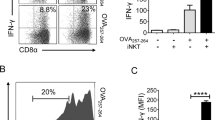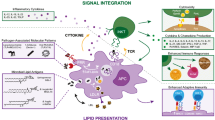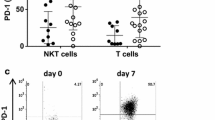Abstract
Invariant natural killer T (iNKT) cells play important roles in antimicrobial defense and immune-regulation. We have previously shown that iNKT cells express certain toll-like receptors (TLR), and that TLR co-stimulation of iNKT cells in the presence of suboptimal concentrations of T cell receptor (TCR) agonists enhances cellular activation. In the present study, we investigated the regulatory effects of CpG oligonucleotides in mouse primary hepatic and splenic iNKT cells and in DN32.D3 iNKT cells. We show that CpG treatment of iNKT cells in the presence of higher concentrations of TCR agonists (α-GalCer or anti-CD3 mAb) results in the up-regulation of TLR9 in iNKT cells with a concurrent reduction in their cellular activation, as assessed by their production of IL-2, IL-4 and IFN-γ compared with controls. CpG-mediated down-regulation of iNKT cell activation has been found to depend, at least in part, on signaling by MyD88, a critical adapter moiety downstream of TLR9 signaling. Mechanistically, iNKT cells treated with CpG in the presence of TCR agonists show inhibition of MAPK signaling as determined by the levels of ERK1/2 and p38 MAPKs. Furthermore, CpG treatment leads to an increased induction of phosphatases, DUSP1 and SHP-1, that seem to impede MAPK and TCR signaling, resulting in the negative regulation of iNKT cell activation. Our findings therefore suggest a novel regulatory role for CpG in iNKT cells in the mediation of a negative feedback mechanism to control overactive iNKT cell responses and hence to avoid undesirable excessive immunopathology.






Similar content being viewed by others
References
Agrawal A, Dillon S, Denning TL, Pulendran B (2006) ERK1−/− mice exhibit Th1 cell polarization and increased susceptibility to experimental autoimmune encephalomyelitis. J Immunol 176:5788–5796
Caron G, Duluc D, Fremaux I, Jeannin P, David C, Gascan H, Delneste Y (2005) Direct stimulation of human T cells via TLR5 and TLR7/8: flagellin and R-848 up-regulate proliferation and IFN-gamma production by memory CD4+ T cells. J Immunol 175:1551–1557
Chen P, Li J, Barnes J, Kokkonen GC, Lee JC, Liu Y (2002) Restraint of proinflammatory cytokine biosynthesis by mitogen-activated protein kinase phosphatase-1 in lipopolysaccharide-stimulated macrophages. J Immunol 169:6408–6416
Chi H, Barry SP, Roth RJ, Wu JJ, Jones EA, Bennett AM, Flavell RA (2006) Dynamic regulation of pro- and anti-inflammatory cytokines by MAPK phosphatase 1 (MKP-1) in innate immune responses. Proc Natl Acad Sci U S A 103:2274–2279
Chiba A, Dascher CC, Besra GS, Brenner MB (2008) Rapid NKT cell responses are self-terminating during the course of microbial infection. J Immunol 181:2292–2302
Cottalorda A, Verschelde C, Marcais A, Tomkowiak M, Musette P, Uematsu S, Akira S, Marvel J, Bonnefoy-Berard N (2006) TLR2 engagement on CD8 T cells lowers the threshold for optimal antigen-induced T cell activation. Eur J Immunol 36:1684–1693
Dong C, Davis RJ, Flavell RA (2002) MAP kinases in the immune response. Annu Rev Immunol 20:55–72
Gardner TR, Chen Q, Jin Y, Ajuebor MN (2010) Toll-like receptor 3 ligand dampens liver inflammation by stimulating Valpha 14 invariant natural killer T cells to negatively regulate gammadeltaT cells. Am J Pathol 176:1779–1789
Gelman AE, Zhang J, Choi Y, Turka LA (2004) Toll-like receptor ligands directly promote activated CD4+ T cell survival. J Immunol 172:6065–6073
Gong J, Yu H, Liu T, Gill JJ, Chambers JR, Wheatcroft R, Sabour PM (2008) Effects of zinc bacitracin, bird age and access to range on bacterial microbiota in the ileum and caeca of broiler chickens. Am J Pathol 104:1372–1382
Gonzalez-Navajas JM, Fine S, Law J, Datta SK, Nguyen KP, Yu M, Corr M, Katakura K, Eckman L, Lee J, Raz E (2010) TLR4 signaling in effector CD4+ T cells regulates TCR activation and experimental colitis in mice. J Clin Invest 120:570–581
Gorjestani S, Rider V, Kimler BF, Greenwell C, Abdou NI (2008) Extracellular signal-regulated kinase 1/2 signalling in SLE T cells is influenced by oestrogen and disease activity. Lupus 17:548–554
Hebeisen M, Baitsch L, Presotto D, Baumgaertner P, Romero P, Michielin O, Speiser DE, Rufer N (2013) SHP-1 phosphatase activity counteracts increased T cell receptor affinity. J Clin Invest 123:1044–1056
Heymann F, Tacke F (2016) Immunology in the liver—from homeostasis to disease. Nat Rev Gastroenterol Hepatol 13:88–110
Hinks TS (2016) Mucosal-associated invariant T cells in autoimmunity, immune-mediated diseases and airway disease. Immunology 148:1–12
Hou X, Hao X, Zheng M, Xu C, Wang J, Zhou R, Tian Z (2016) CD205-TLR9-IL-12 axis contributes to CpG-induced oversensitive liver injury in HBsAg transgenic mice by promoting the interaction of NKT cells with Kupffer cells. Cell Mol Immunol 13:1–10
Jeffrey KL, Camps M, Rommel C, Mackay CR (2007) Targeting dual-specificity phosphatases: manipulating MAP kinase signalling and immune responses. Nat Rev Drug Discov 6:391–403
Johnson TV, Camras CB, Kipnis J (2007) Bacterial DNA confers neuroprotection after optic nerve injury by suppressing CD4+CD25+ regulatory T-cell activity. Invest Ophthalmol Vis Sci 48:3441–3449
Johnson DJ, Pao LI, Dhanji S, Murakami K, Ohashi PS, Neel BG (2013) Shp1 regulates T cell homeostasis by limiting IL-4 signals. J Exp Med 210:1419–1431
Juno JA, Keynan Y, Fowke KR (2012) Invariant NKT cells: regulation and function during viral infection. PLoS Pathog 8:e1002838
Kabelitz D (2007) Expression and function of toll-like receptors in T lymphocytes. Curr Opin Immunol 19:39–45
Komai-Koma M, Jones L, Ogg GS, Xu D, Liew FY (2004) TLR2 is expressed on activated T cells as a costimulatory receptor. Proc Natl Acad Sci U S A 101:3029–3034
Kudo D, Toyama M, Aoyagi T, Akahori Y, Yamamoto H, Ishii K, Kanno E, Maruyama R, Kaku M, Kushimoto S, Kawakami K (2013) Involvement of high mobility group box 1 and the therapeutic effect of recombinant thrombomodulin in a mouse model of severe acute respiratory distress syndrome. Clin Exp Immunol 173:276–287
Kulkarni RR, Haeryfar SM, Sharif S (2010) The invariant NKT cell subset in anti-viral defenses: a dark horse in anti-influenza immunity? J Leukoc Biol 88:635–643
Kulkarni R, Behboudi S, Sharif S (2011) Insights into the role of toll-like receptors in modulation of T cell responses. Cell Tissue Res 343:141–152
Kulkarni RR, Villanueva AI, Elawadli I, Jayanth P, Read LR, Haeryfar SM, Sharif S (2012) Costimulatory activation of murine invariant natural killer T cells by toll-like receptor agonists. Cell Immunol 277:33–43
Landrigan A, Wong MT, Utz PJ (2011) CpG and non-CpG oligodeoxynucleotides directly costimulate mouse and human CD4+ T cells through a TLR9- and MyD88-independent mechanism. J Immunol 187:3033–3043
Lantz O, Bendelac A (1994) An invariant T cell receptor alpha chain is used by a unique subset of major histocompatibility complex class I-specific CD4+ and CD4-8- T cells in mice and humans. J Exp Med 180:1097–1106
Liu Y, Shepherd EG, Nelin LD (2007) MAPK phosphatases—regulating the immune response. Nat Rev Immunol 7:202–212
Maddur MS, Kaveri SV, Bayry J (2012) Regulation of human dendritic cells by B cells depends on the signals they receive. Blood 119:3863–3864
Maddur MS, Sharma M, Hegde P, Stephen-Victor E, Pulendran B, Kaveri SV, Bayry J (2014) Human B cells induce dendritic cell maturation and favour Th2 polarization by inducing OX-40 ligand. Nat Commun 5:4092
Marshall JD, Fearon KL, Higgins D, Hessel EM, Kanzler H, Abbate C, Yee P, Gregorio J, Cruz TD, Lizcano JO, Zolotorev A, McClure HM, Brasky KM, Murthy KK, Coffman RL, Nest GV (2005) Superior activity of the type C class of ISS in vitro and in vivo across multiple species. DNA Cell Biol 24:63–72
Nagarajan NA, Kronenberg M (2007) Invariant NKT cells amplify the innate immune response to lipopolysaccharide. J Immunol 178:2706–2713
Pages G, Guerin S, Grall D, Bonino F, Smith A, Anjuere F, Auberger P, Pouyssegur J (1999) Defective thymocyte maturation in p44 MAP kinase (Erk 1) knockout mice. Science 286:1374–1377
Paget C, Mallevaey T, Speak AO, Torres D, Fontaine J, Sheehan KC, Capron M, Ryffel B, Faveeuw C, Leite de Moraes M, Platt F, Trottein F (2007) Activation of invariant NKT cells by toll-like receptor 9-stimulated dendritic cells requires type I interferon and charged glycosphingolipids. Immunity 27:597–609
Pfaffl MW (2001) A new mathematical model for relative quantification in real-time RT-PCR. Nucleic Acids Res 29:e45
Rincon M, Derijard B, Chow CW, Davis RJ, Flavell RA (1997) Reprogramming the signalling requirement for AP-1 (activator protein-1) activation during differentiation of precursor CD4+ T-cells into effector Th1 and Th2 cells. Genes Funct 1:51–68
Salojin KV, Owusu IB, Millerchip KA, Potter M, Platt KA, Oravecz T (2006) Essential role of MAPK phosphatase-1 in the negative control of innate immune responses. J Immunol 176:1899–1907
Selvanantham T, Escalante NK, Cruz Tleugabulova M, Fieve S, Girardin SE, Philpott DJ, Mallevaey T (2013) Nod1 and Nod2 enhance TLR-mediated invariant NKT cell activation during bacterial infection. J Immunol 191:5646–5654
Sharif S, Arreaza GA, Zucker P, Mi QS, Delovitch TL (2002) Regulation of autoimmune disease by natural killer T cells. J Mol Med 80:290–300
Shepherd EG, Zhao Q, Welty SE, Hansen TN, Smith CV, Liu Y (2004) The function of mitogen-activated protein kinase phosphatase-1 in peptidoglycan-stimulated macrophages. J Biol Chem 279:54023–54031
Stuart JK, Bisch SP, Leon-Ponte M, Hayatsu J, Mazzuca DM, Maleki Vareki S, Haeryfar SM (2010) Negative modulation of invariant natural killer T cell responses to glycolipid antigens by p38 MAP kinase. Int Immunopharmacol 10:1068–1076
Suzuki Y, Wakita D, Chamoto K, Narita Y, Tsuji T, Takeshima T, Gyobu H, Kawarada Y, Kondo S, Akira S, Katoh H, Ikeda H, Nishimura T (2004) Liposome-encapsulated CpG oligodeoxynucleotides as a potent adjuvant for inducing type 1 innate immunity. Cancer Res 64:8754–8760
Takahashi T, Chiba S, Nieda M, Azuma T, Ishihara S, Shibata Y, Juji T, Hirai H (2002) Cutting edge: analysis of human V alpha 24+CD8+ NK T cells activated by alpha-galactosylceramide-pulsed monocyte-derived dendritic cells. J Immunol 168:3140–3144
Tupin E, Kinjo Y, Kronenberg M (2007) The unique role of natural killer T cells in the response to microorganisms. Nat Rev Microbiol 5:405–417
Tyznik AJ, Tupin E, Nagarajan NA, Her MJ, Benedict CA, Kronenberg M (2008) Cutting edge: the mechanism of invariant NKT cell responses to viral danger signals. J Immunol 181:4452–4456
Vilaysane A, Muruve DA (2009) The innate immune response to DNA. Semin Immunol 21:208–214
Villanueva AI, Haeryfar SM, Mallard BA, Kulkarni RR, Sharif S (2014) Functions of invariant NK T cells are modulated by TLR ligands and IFN-alpha. Innate Immun 21:275–288
Wu L, Van Kaer L (2009) Natural killer T cells and autoimmune disease. Curr Mol Med 9:4–14
Xu T, Wu X, Chen Q, Zhu S, Liu Y, Pan D, Chen X, Li D (2014) The anti-apoptotic and cardioprotective effects of salvianolic acid a on rat cardiomyocytes following ischemia/reperfusion by DUSP-mediated regulation of the ERK1/2/JNK pathway. PLoS One 9:e102292
Zanin-Zhorov A, Cohen IR (2013) Signaling via TLR2 and TLR4 directly down-regulates T cell effector functions: the regulatory face of danger signals. Front Immunol 4:211
Acknowledgements
The authors thank the NIH core tetramer facility at Emory University, Atlanta, Ga., USA for providing CD1d tetramers. They are also grateful to Emory University and University of Guelph Flow Cytometry Core Facility for help with flow cytometry. This work was partially supported by the National Institutes of Health (NIH) grants R01AI086133 and U19AI083019 to K.M.-K.
Author information
Authors and Affiliations
Corresponding author
Ethics declarations
Conflict of interest
The authors of this manuscript declare that they have no conflict of interest.
Statement on the welfare of animals
The authors state that all applicable international, national, and/or institutional guidelines for the care and use of animals were followed, and all procedures performed in studies involving animals were in accordance with the ethical standards of the institution or practice at which the studies were conducted.
Additional information
Alexander Ian Villanueva should be considered as the co-first author
Rights and permissions
About this article
Cite this article
Kulkarni, R.R., Villanueva, A.I., Read, L.R. et al. CpG oligonucleotide-mediated co-stimulation of mouse invariant natural killer T cells negatively regulates their activation status. Cell Tissue Res 369, 541–554 (2017). https://doi.org/10.1007/s00441-017-2631-y
Received:
Accepted:
Published:
Issue Date:
DOI: https://doi.org/10.1007/s00441-017-2631-y




